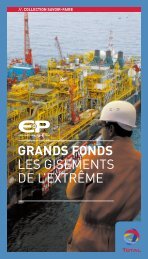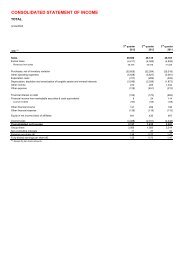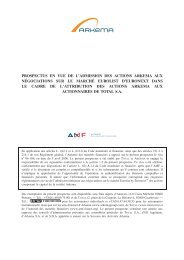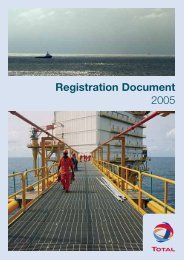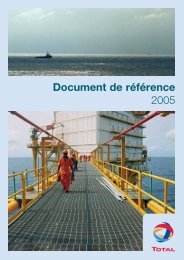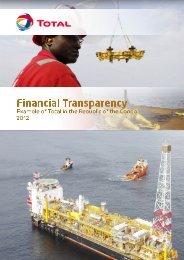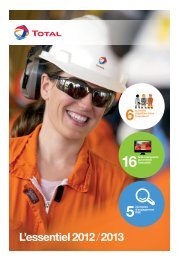Registration document 2007 - Total.com
Registration document 2007 - Total.com
Registration document 2007 - Total.com
Create successful ePaper yourself
Turn your PDF publications into a flip-book with our unique Google optimized e-Paper software.
In 2006, the principal market benchmarks stood at historically high levels:<br />
2006 2005 2004 min 2006 max 2006<br />
Brent ICE Futures - 1st Line (a) ($/b) 66.11 55.25 38.04 57.87 (2-Nov) 78.30 (7-Aug)<br />
Gasoil ICE Futures - 1st Line (a) ($/t) 580.4 507.9 347.5 510.5 (12-Jan) 668.8 (10-Aug)<br />
VLCC Ras Tanura Chiba — BITR (b) ($/t) 14.52 13.91 19.97 8.35 (6-Apr) 27.21 (25-Jan)<br />
(a) 1 st line: Quotation for first month nearby delivery ICE Futures.<br />
(b) VLCC: Very Large Crude Carrier. Data estimated from BITR’s market quotations. BITR: Baltic International Tanker Routes.<br />
Throughout 2006, the Trading division maintained a level of<br />
activity similar to levels attained in 2004 and 2005, trading<br />
physical volumes of crude oil and refined products amounting to<br />
an average of approximately 5 Mb/d.<br />
Shipping<br />
The principal activity of the Shipping division is to arrange the<br />
transportation of crude oil and refined products necessary for<br />
Group activities. The Shipping division provides a wide range of<br />
shipping services required by the Group to develop its activities<br />
and maintains a rigorous safety policy. Like a certain number of<br />
other oil <strong>com</strong>panies and shipowners, the Group uses freight-rate<br />
derivative contracts in its shipping activity in order to manage its<br />
exposure to freight-rate fluctuations.<br />
In 2006, the Shipping division of the Group chartered 3,170<br />
voyages to transport approximately 127 Mt of oil. As of<br />
December 31, 2006, the Group employs a fleet made up of sixtythree<br />
vessels chartered under long-term or medium-term<br />
agreements (including six LPG tankers). The fleet is modern, with<br />
an average age of approximately five years and is predominately<br />
<strong>com</strong>prised of double-hulled vessels.<br />
Throughout 2006, world crude tanker tonnage increased by<br />
4.9%.This was the fourth consecutive year of high-growth in<br />
terms of available crude tonnage (+7.5% in 2005, +4.5% in 2004<br />
and +5 % in 2003). Tonnage demand in 2006 was less sustained<br />
than the year before, due to the slowdown in the growth of<br />
global oil demand.<br />
(1) Source: PIRA.<br />
Business overview<br />
Trading & Shipping - Downstream<br />
2<br />
These trends reinforce a structural surplus of available tonnage,<br />
particularly in a situation where the orderbook reaches a historical<br />
record, both in absolute value (124 million deadweight tons) and<br />
as a percentage of the active fleet (30% of the global fleet,<br />
between 30% and 65% according to the different tanker<br />
segments).<br />
On the crude tanker segment, after the seasonal rise observed<br />
during the last quarter of 2005, the chartering markets dropped<br />
significantly throughout the year 2006, apart from some volatile<br />
peaks. Following a strengthening of freight rates during the<br />
second and third quarter, the rates declined significantly after<br />
August 2006, particularly for VLCCs. The situations in both the<br />
crude and the petroleum products freight markets during the last<br />
quarter of 2006 thus were not <strong>com</strong>parable to the historical level<br />
observed at the end of 2004 and 2005.<br />
The large number of deliveries expected in <strong>2007</strong>, which should<br />
not be offset by the demolition of ships, should lead to an<br />
increase in tonnage supply (+5.8%) (1) greater than the increase in<br />
ton-miles (+3%) (1) .<br />
TOTAL – <strong>Registration</strong> Document 2006 49




